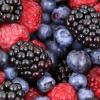How Good Gut Bacteria Could Transform Your Health
By Gretel Schueller, "The Wild World Within,"July/August 2014
Scientist Jeff Leach is studying gut microbes that have the potential to improve our weight, mood, allergies, heart and more.
Barefoot and coated in fine desert dust, Jeff Leach hops around the fire, adjusting logs. Its roaring glow provides the only light as the sun sinks behind the Chisos Mountains and the desert air cools.
It’s dinnertime here in Terlingua, the tiny town in southwest Texas that Leach sometimes calls home. We’ve just finished piercing roughly chopped pieces of leek, onion, beef, green peppers and garlic onto metal skewers, and Leach works at balancing them over the fire. Juices sizzle and the roasting aroma makes my mouth water.
“Have you ever held a colon in your hands?” he asks. Whoa…
Talk of belly bacteria, stool samples, bowel movements or your colon isn’t supposed to be part of polite (or appetizing) dinner conversation. But eating with Leach requires new rules of etiquette. Actually, it requires rethinking a whole slew of “rules.”
Once you get talking to Leach and his research colleagues around the world, you quickly realize it’s not just about changing dinner-table etiquette—we may be changing how we talk about health entirely. It all centers on the trillions of bacteria living in our gut.
We are more microbe than human. We each carry an estimated four to ten times more bacterial cells than human cells. If you could mush all the bacteria together they’d be the size of a basketball and weigh about three pounds.
The invisible world of bacteria that live on and in us is called the microbiome; the gut microbiome is the term for the diverse collection living along our intestinal tract, where the bulk of our tiny partners make their home.
Research on the gut microbiome has exploded over the past few years. This bold new frontier may just provide the string theory of all human disease. “Name just about any ailment plaguing us and you’ll find some researchers discovering the microbial angle for a connection,” says Leach, whose latest book, Bloom: Reconnecting with Your Primal Gut in a Modern World, is due out this fall. Recent studies have implicated gut microbes in everything from autism and depression to cancer and diabetes to heart disease and obesity. “It’s a watershed moment for human health,” says Leach.
He should know. Leach—with his frenetic energy, powerful charisma and uncanny ability to step back and connect diverse dots—is one of the most visible leaders of the gut-health movement. In 2012, Leach founded the Human Food Project, a global effort to study how diet affects the microbial world within us.
A major arm of that is the American Gut Project, thought to be the largest microbiome project in the world, co-led by Rob Knight, Ph.D., a professor at the University of Colorado’s BioFrontiers Institute and a Howard Hughes Medical Institute Early Career Scientist. The goal is to map the diversity of the human gut—and tease out patterns shaped by diet, age and lifestyle to understand the factors most important for a healthy gut microbiome.
So far, more than 7,000 people have signed up for the gut project. After completing a questionnaire and a 7-day food journal, and paying $99, participants send a fecal sample to be analyzed.
Some of the questions might seem odd: How many different plants do you eat in a week? Born by C-section? Own a pet? Used an antibiotic in the past month?
But Leach explains that all of these things affect your microbiome. And what he and his colleagues are finding is that Americans generally have less-diverse gut microbiomes than other populations. No one knows what the perfect gut microbiome should look like—or if there even is one. But one thing is clear: diversity is key. And we’re losing it.
Building the Microbiome
Until the moment we are born, we are still 100 percent human. In other words, bacteria-free. Most of us get our first dose of microbes while traveling through the birth canal. The second big dose comes from breast milk. As babies grow, they pick up critters from dirt, pets, family members and friends. By age 3, the microbiome has pretty much set up camp.
But changing lifestyles are chipping away at that microbiome. Early studies indicate that children born by C-section—which reduces the microbes an infant is first exposed to—have a higher risk of celiac disease, obesity and type 1 diabetes. Add to that decreased breast-feeding and “our overzealous use of antibiotics,” says Leach, who compares what antibiotics do to the gut microbiome to clear-cutting a forest.
From birth to age 5, children receive more antibiotics than during any other five-year period in their lives. One of Leach’s colleagues, New York University microbiologist Martin Blaser, M.D., believes antibiotics have “deranged” the microbiome—even causing some species to go extinct—and that their overuse is why many health problems, including type 1 diabetes, obesity and allergies, are on the rise.
Numerous studies also show that scrubbing away our microbes may be weakening our bodies’ natural defenses—something Leach has experienced firsthand: 12 years ago, at age 2, his daughter was diagnosed with type 1 diabetes, an autoimmune disease.
“My daughter was born C-section—strike 1; breast-fed very short—strike 2; strike 3, she received antibiotics at a very young age; strike 4, she lived in an environment where we basically wet-wiped everything and bathed her twice a day.” Leach feels strongly that her disease is a by-product of our culture.
At the time, Leach, who has a Ph.D. in anthropology, was studying how ancient people acquired and cooked foods. “When my daughter was diagnosed, the only thing I could do was to try to understand why she was sick. I just started emailing microbiologists and asking questions.”
He learned that this autoimmune disease is an overreaction of the immune system. And the bulk of immune cells live in the gut.
So into the gut he went—and stayed.
His new focus is actually not that much of a leap from anthropology. “If microbiome research is anything, it’s anthropology—about how people interact with their environment,” notes Leach.
Here in this remote desert town, Leach’s life is a sharp contrast to his sanitized suburban past. [ pagebreak ] (He and his wife divorced and the children live with her most of the year.) When he’s not traveling for research, Leach spends time in an adobe ruin that he’s rehabbing.
The fire pit is his kitchen. He has an open-air shower and the toilet is in a doorless shed. Only one 7-by-12-foot room is closed to the elements; it includes a single cot, desk, laptop computers, leaning towers of research papers and…a few dozen poison-tipped arrows (we’ll get to those soon). Out here, Leach is reconnecting with his microbes because he knows how critical they are.
Most of our resident gut bacteria are real workhorses. Some aid in digestion and produce enzymes to break down foods. Others make vitamins, like B12 and K, and other vital compounds, such as the feel-good chemical serotonin. A few help keep the intestinal lining impenetrable. Some gut bacteria help regulate metabolism. And others boost immunity and fight pathogens.
Of course, not all bacteria are beneficial. Some amplify inflammation or cause life-threatening infections. But we carry them all naturally; they only create problems when the microbial balance becomes disturbed.
There are many ways our microbiome can get off-kilter and make us prone to infections or disease. For example, taking antibiotics shifts the balance of microbes in our gut. As a result, the infectious dose of Salmonella is a thousand times lower for someone who’s on antibiotics. Diet is another way we can tip the balance unfavorably.
Essential Fuel for Your Microbiome
“We should start thinking about diets from the perspective of what we should be feeding our gut microbes,” says Leach. “Nothing matters more.”
A seminal study published in Nature last year compared the gut microbiome of people eating an entirely animal-based diet (meats, cheeses and eggs) with one that was completely plant-based (grains, legumes, vegetables and fruits). Just one day on either diet was enough to dramatically shift the gut microbiome of participants. While researchers knew that diet could cause changes to the gut microbiome, this was the first study to show such a rapid effect in people.
Leach is doing similar, informal tests on himself. Since January 1 of this year, he’s been trying out different diets: fermented foods, vegan, raw food, Paleo and others. He’s following each one for 10 to 12 days, collecting daily stool samples. By “whacking his microbiome around” (as he refers to it) he hopes to zero-in on the key foods that fuel the good and bad players of the gut.
His first trial was a high-fat (70 percent of calories), average-protein (25 percent) diet with little carbohydrate and near zero dietary fiber. This diet, he explains, starved his microbes of food. Proteobacteria, practically nonexistent before, increased.
“This group includes a lot of your bad guys—E. coli, Salmonella. They are associated with inflammation and may increase your risk of disease.” At the same time, numbers of actinobacteria, typically considered good guys and known to suppress proteobacteria, dropped.
He’s since done several variations of this diet—adjusting fat, carbs, protein and fiber. “It’s the fiber that’s the game changer,” Leach says. Adding 40 to 60 grams of fiber per day seems to shift his gut microbiome toward a diverse, more beneficial mix of microbes.
Here’s why: like all living things, bacteria need food to survive. They do that by fermenting—that’s the way these guys “eat”—dietary fiber. But gut bacteria are picky. Only certain types of fiber will do—and most of us don’t eat enough of the kind that bacteria need.
Fibers are like pearl necklaces of varying bead-length. Most fibers we eat are so short, they get chomped long before they make it to where bacteria are concentrated, the beginning of the large intestine, aka the colon.
Two fiber types long enough to survive the length of our GI tract are fructan and cellulose fibers—part of a group of foods known as prebiotics, foods that encourage the growth of good bacteria. Cellulose fibers are in the tough parts of veggies and fruit we tend to toss—like the stalks of broccoli and bottoms of asparagus—and the stringy bits of celery. Fructan fibers are found in many fruits and vegetables—from artichokes to onions.
But how you prepare these foods also matters. That’s because heat breaks down fibers. Consider the onion—a good source of fructan: the average chain length of fructan in an onion is 26. A little bit of cooking breaks the onion fibers down to 8 or 10 beads. The shorter the chain, the sweeter the food—which is why deliciously sweet caramelized onions retain little fructan fiber benefit.
Leach does a little show-and-tell at Terlingua’s only grocery, the Cottonwood General Store. “This is probably the healthiest thing in the store for your gut microbiome,” he says, holding a leek almost as long as his arm.
He points to the white part: “These store fructans. I’d say this probably does more good for you than a wheelbarrow full of yogurt.” Then, he points to the green top of the leek: “That’s the cellulose, which has a chain length of a couple thousand ‘beads.’”
A few onlookers stare at the leek in awe. Silence. “You could eat this whole leek and change your microbiome in 48 hours,” Leach proclaims. In other words, if you eat this, the good guys will come.
In contrast, he pulls out a bag of baby carrots. “We think we’re doing well when we steam these for dinner,” Leach says. And for some purposes we are. But there’s not much here to feed your gut microbes.
When he’s not using himself to road-test various diets, Leach practices what he preaches, eating a (lightly sautéed) leek a day—“The whole thing,” he emphasizes, “from muddy roots to fibrous green tops.” In fact, he convinced this tiny grocery store in the middle of a desert to carry leeks.
Gut microbes feast away on those fibers in a fermentation frenzy. Some of fermentation’s most beneficial by-products are short-chain fatty acids that provide energy for intestinal cells, help repair the colon’s protective lining and increase the acidity of the colon. Most infection-causing bacteria—as well as other microscopic troublemakers like parasites—don’t do well in acidic environments.
A Gut Without Fiber
Starve your gut friends and the consequences can be toxic. Without fiber, the colon environment favors unsavory microbes. No fiber also means no more short-chain fatty acids, paving the way for less-desirable bacteria to flourish.
Over time, starving bacteria start eating us—specifically the lining of the colon. Normally, the intestinal lining is a selective barrier between our digestive tube and the rest of our body—harder to break into than a trendy club; good bacteria like bifidobacterium act as buff bouncers, making sure only the worthy get past. Over time, eating a low-fiber diet can weaken these defenses, allowing bits of dead bacteria to get into the bloodstream. “This is what causes low-grade inflammation,” Leach explains.
Chronic, low-grade inflammation can raise your risk for various chronic diseases—and it is a hallmark of metabolic syndrome, a collection of conditions that can include insulin resistance, elevated blood sugar and high blood pressure. Patrice Cani, Ph.D., a microbiologist at the Catholic University of Louvain in Belgium, is one of the leading researchers looking at the connection between inflammation and gut microbes.
His work has shown that a high-fat, low-fiber diet increases inflammation—that’s probably not a big surprise. The real shocker came when he and his colleagues fed gut-friendly plant fibers to mice on a high-fat diet: they were able to stop the whole inflammation cycle that fuels metabolic syndrome.
Our Original Microbiome
After our fireside dinner, Leach invites me into his adobe ruin to show me photos of the people he says will help us better understand the gut microbiome. They carry a gut microbe mix that’s close to the one our ancestors had, Leach believes. Photos of men hunting, straw huts and smiling children cover the walls. Leach is animated and starts pulling out souvenirs to show me: a drum, sandals made of old tires.
Then he brings out the arrows. Colorful feathers decorate the tail ends and the metal tips are sharp—and covered with dried blood. “Careful, don’t touch the tips. They’re poison.” The arrows belong to the Hadza of Tanzania, “the last true hunter-gatherers in the world,” he says. “They live where humans evolved; it’s as close as we can get to the original microbiome.”
For the past year, Leach has been spending time with this dwindling tribe of roughly 300 people. The Hadza still hunt and gather the majority of their food, have limited access to antibiotics, are born naturally, breast-feed for two-plus years, drink untreated water and live outdoors 24-7—all things that encourage a diverse gut microbiome.
While infant mortality—as in many developing countries—is high, Hadza adults are healthy and rarely suffer from “modern” diseases like heart disease, diabetes, allergies and cancer, according to Leach. Their diet shifts dramatically over the year: during the rainy season from February to April, as many as 80 percent of their calories come from honey; in contrast, late fall is characterized by meat bingeing. What remains constant is their average daily fiber intake: more than 100 grams. Most comes from the seeds and pulp of the fructan-rich baobab fruit and fibrous tubers.
It’s here with the Hadza that Leach sees the puzzle pieces fitting together—how the “dirty” world of the Hadza mirrors the robust world of their gut. “Once you’ve sat under a baobab tree for two weeks and watched how they drink water, build their houses, handle animals, travel—and the things they don’t do—there’s a lot of eureka moments.”
Fieldwork to help understand the bigger picture is what Leach does best. For the analysis and lab work, he has brought together a global “dream team,” as he calls them.
“Intellectually, [Leach’s] background and perspective are huge assets to the project,” says Justin Sonnenburg, Ph.D., a microbiologist at Stanford University who collaborates with Leach and runs one of the labs involved in the Human Food Project. He receives some of the stool samples Leach collects from the tribe. Other samples arrive to other “dream team” members.
The first report on the Hadza microbiome was recently published, showing the hunter-gatherers probably have the most diverse gut microbiome in the world, with hundreds more species than most other people. “It suggests that the microbiome is going through extinctions as food becomes more processed and less diverse,” notes Sonnenburg. “What does it mean if the world is heading down a path of reduced microbiome diversity?” He points to the fact that most Western diseases are spurred by inflammation.
This is why, taking a few lessons from the Hadza, we could do with a little rewilding of our gut microbiome.
Right now, Leach is on a break from his diet experiment. So we sip tequila and eat some queso and chips at the local watering hole. (Not so gut-friendly, he acknowledges, but the occasional treat is OK.) I dunk a chip as Leach sketches a colon on my notepad.
Patrons at a nearby table nod with understanding—they’re familiar with Leach, who they sometimes affectionately call “Dr. Sh*t.” They appreciate his crusade as an environmentalist for the ecosystem within us.
There’s certainly more to be discovered in this diverse world tucked inside our bellies. But Leach believes we should already feel empowered. His basic message: increase and diversify your plant intake. The foods you pick “should be chewy, should get stuck in your teeth,” he says. “Eat the end of the asparagus, the stalk of the broccoli. Become a little more adventurous in the produce section. This is a part of your health you can control. You can shift your microbiome.”
Gretel H. Schueller has written for Scientific American, Discover and New Scientist. She is also a children’s book author.

































































